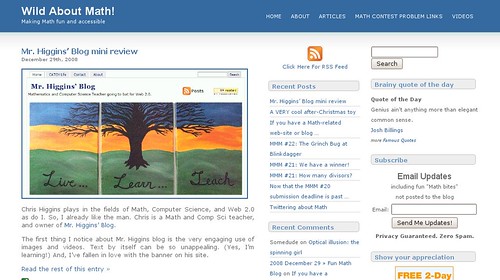I have started the countdown to Christmas, and 2008 is approaching the end. Since the major journals in mathematics education are having a few slow days at the moment, I found it useful to start reflecting about the year that is soon behind us, and the one which lies ahead.
I started this blog in February this year, and in
the welcome post on February 5, I wrote:
There are so many journals, so many conferences, so many web-sites that cover research in mathematics education. This blog will be my humble attempt to cover the most important ones. In the sidebar, you can find feeds from the most important scientific journals in mathematics education research. In this blog, I will comment on new and interesting (to me at least) articles in these and other journals. I will also try to follow some of the most important conferences in mathematics education, as well as sharing interesting bookmarks regarding mathematics education.
Now, ten months later, I think it's appropriate to look back and see where I have come. The blog started out as a personal wish to get to know my own field of research better, and I personally feel that I have been extremely successful in this realm! I never advertised much for this blog, but when I started tracking the statistics with
Google Analytics in late June, I realized that lots of people from all over the world actually read the blog!
Between July 1 and December 1, the blog had 5423 unique visitors, from 114 countries. I know this doesn't sound like a lot, but for a niche blog like this, I think it is actually quite good. For me, it is also interesting to note that my own country - Norway - is only in the third spot when it comes to number of visitors.
Most of my time has been spent on covering articles from peer-reviewed journals in mathematics education, and I have also covered some conferences. This is something I intend to continue doing, but I have been thinking about different possible ways of doing this. First, I have thought about the possibility of writing more about some main articles in a way that people who are not researchers can relate to. I think it is important for researchers to communicate their results not only to fellow researchers. Unfortunately, but understandably, most teachers do not read our research journals! So, I have started thinking about writing some abstracts or impressions of research articles that teachers, parents and others who are interested but not researchers might relate to. I have also started thinking about making a stronger effort into providing an even better overview of the field (indexing journal articles, updating the conference calendar more, etc.). These are some of my own thoughts. But I am also interested in learning about your ideas! So, if you read this blog frequently, or if this is the first time you drop by ... What do you think? What would be more useful to you? Please write comments to this post, or send me an e-mail to let me know!
I already know what an incredible learning experience this blog has been for me, but now I want to know how I can make it a better experience for you - the readers - as well!
 Sol Lederman has a very nice blog about mathematics, and the focus is on "making math fun and accessible". The blog itself is called "Wild About Math!", and it is definitely worth checking out!
Sol Lederman has a very nice blog about mathematics, and the focus is on "making math fun and accessible". The blog itself is called "Wild About Math!", and it is definitely worth checking out! 




